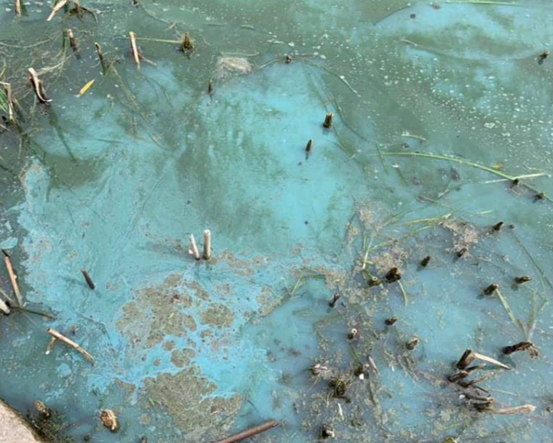
Tuesday, July 26, 2022, the Allegan County Health Department received a call that cyanobacteria bloom was detected near the beach at a campground on Swan Lake in Cheshire Township. Nicole Taubner, Sanitarian & Water Quality Specialist with ACHD, took samples and did a preliminary test of the water to determine the toxicity in the harmful algal blooms (HABs). The samples were reported to the Michigan Department of Environment, Great Lakes, and Energy (EGLE) and sent to the DHHS laboratory for more comprehensive testing.
Aaron Parker, an aquatic biologist with EGLE, shared in an email, “Nicole collected three samples at the beach. Preliminary results indicated that microcystin (cyanotoxin) is present ranging from 1-10 ug/l to >10 ug/l. As a reminder, the E.P.A.’s recreational guidance for microcystin is 8 ug/l. Based on these results, if cyanobacteria are observed in other parts of the lake, you should assume that it also contains similar toxin concentrations. Nicole has sent the samples that she collected to the DHHS laboratory in Lansing for further analysis.”
Algae needs nutrients to form. The shorelines contain more nutrients because of the lack of circulation. The nutrients can be carried in runoff water, where streams dump into lakes, and where other pollutants exist.
Algae is part of the lake environment. Some is completely safe while others may be dangerous. Because there is a wide variety of extremely complex algae, only specialized testing can determine the different levels of toxicity.
The residents and visitors around Swan Lake have been advised to watch for other infestations of algae blooms. But because it is impossible to visually determine the toxicity of blooms, anyone questioning a bloom should contact EGLE by calling the Environmental Assistance Center at 800-662-9278 or by emailing AlgaeBloom@michigan.gov.
In the meanwhile, everyone should avoid:
- areas where water looks like spilled paint or pea soup, floating scums, or has a green sheen. These areas may contain flecks, mats, foam, sheens, streaks or clumps.
- water-related activities where the body comes in contact with the water – skiing, boating where there is a spray, swimming, etc.
- drinking or playing in lake water – this includes pets.
- watering yards and plants with water from impacted bodies of water because of the spray.
If a person or pet is exposed to or swallows HAB infested water: - shower yourself and your pet immediately.
- contact a medical provider or veterinarian if exposed to or ingest HABs.
- contact Poison Control at 800 222-1222 or a doctor.
Watch for Signs of poisoning:
Blue-green algae may produce both nerve toxins (neurotoxins) and liver toxins (hepatotoxins). Symptoms usually develop within a few hours after exposure. These may be vomiting, diarrhea, coughing, weakness, cramping and/or headaches.
Residents of areas with HABs wonder when the blooms will dissipate. Sometimes, heavy rains and mixing or churning of the water will kill the blooms. Cooler temperatures can help kill off blooms. Even though blooms can disappear quickly, they can also reappear. Keeping water mixing and reducing contamination are keys to removing the warm, contaminated water that can propagate the algae.
The Swan Lake residents have been made aware of the situation near the campground swimming area. For those in other areas of the lake, Parker explained, “…if the water is clear, with no visible scums, it should be safe to recreate in.”
This is not Swan Lake’s first rodeo with blue-green algae. Last summer it appeared after the extreme hot spell with no rain and continued into September. Residents are hoping the toxic algae is more localized and dissipates rapidly.
